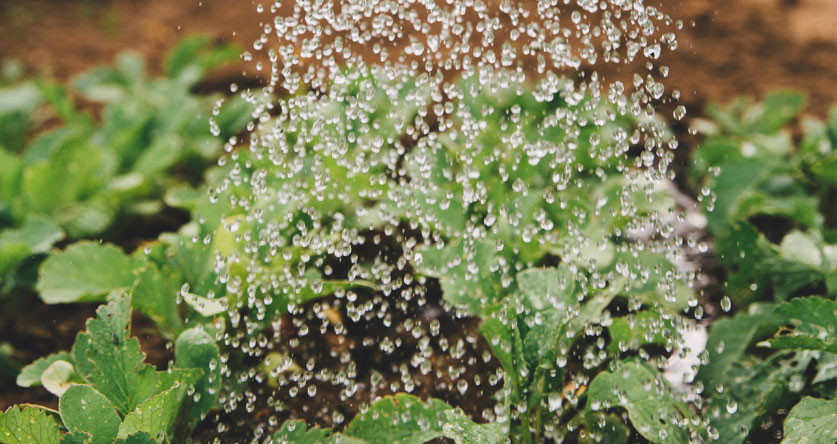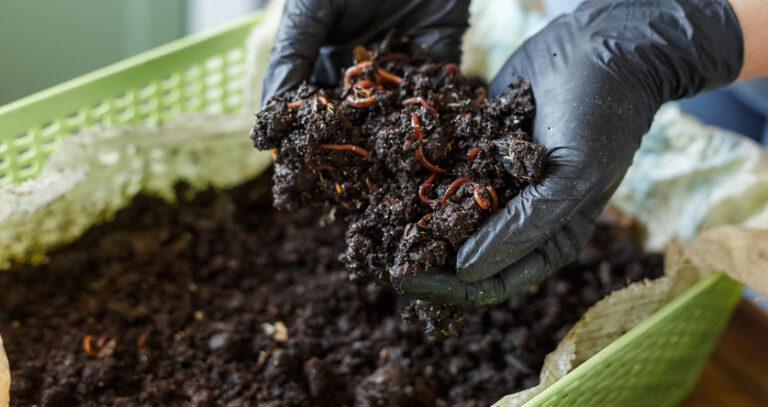Top Dressing With Worm Castings (The Proper Way!)

Worm castings are a fantastic type of organic fertilizer and soil amendment that you can use in many ways.
But it’s not always necessary to dig worm castings into the soil. By far, the easiest way to use worm castings is as a top dressing.
And worm castings can be used to top dress any plant – potted indoor plants, vegetables, flowers, fruit trees, ornamental shrubs, and lawns…
You name it!
Vermicompost contains a marvelous range of macro and micronutrients and beneficial microorganisms that help plants grow healthily and prolifically.
Can You Use Worm Castings As A Top Dressing?
Worm castings can be sprinkled on the soil’s surface around a plant and watered. This is known as a top dressing. As the water trickles into the ground, it carries nutrients and beneficial microbes from the worm castings. This makes them accessible for plants to absorb.
Traditionally, top dressing material consists of a mixture of soil, sand, loam, and peat.
This method is a fantastic way to nourish and support plants growing in pots or raised beds. It’s also a technique that is commonly used for lawns.
And worm castings work very effectively as a top dressing!
In fact, it’s one of the simplest ways to utilize worm castings. There’s no need to make it into worm tea or mix it into the soil, although these are also great ways to use worm compost. Just chuck handfuls of the stuff on your garden 🙂
And worm castings are beneficial as a top dressing for plants in any stage of life – seedlings, flowering, or fruiting plants. The nutrients and microorganisms in worm castings nourish plants and increase their hardiness.
Worm castings are a much better top dressing than traditional top dressing mix. It improves the soil’s natural fertility, reducing the need for artificial fertilizer.
Worm castings are wonderful for improving the soil structure as a top dressing. It helps to aerate the soil and increases its water-holding capacity. This reduces the need for frequent watering.
Similarly to slow-release fertilizer, when you add a layer of worm compost to your plants and vegetation, the nutrient release continues for up to two months.
How To Top Dress With Worm Castings
It is very simple to top dress with vermicompost. You can sprinkle dry worm castings onto the soil surface or around the plant’s stem. Use about 1 cup of castings for every square foot.
Whether you have a landscape garden or a tiny potted patio garden, you should learn how to top dress using worm castings.
The basic technique for garden plants and potted plants follows these steps:
- Apply a layer of worm castings, about 0.5 inches thick, around the base of each plant. The coating should extend about 3 or 4 inches from the plant’s stem.
- Water the plants to help the worm castings’ goodness make its way down into the soil. Make sure you water gently and in small increments so that the force of the water doesn’t displace the worm castings or wash them away. (This is especially important for plants growing in the ground).
- Add more worm castings and repeat this process every month.
Top Dressing Lawn With Worm Castings
Top dressing is the key to growing a lush, even lawn that looks great for most of the year and survives over winter. By using worm castings as a top dressing for your lawn, you drastically enhance the positive effects of top dressing.
It is always best to use worm castings to dress a lawn in the spring or the fall, preferably early in the season or mid-season. Avoid doing this to your grass in summer or winter.
Be sure to check on the weather forecast and make sure you don’t apply top dressing right before heavy rainfall. Intense, torrential downpours wash the top dressing away.
Follow these steps to top-dress your lawn with worm castings:
- Start by mowing the lawn. Cut it nice and short so that the worm castings can easily reach the soil and be evenly distributed.
- If the lawn’s layer of thatch is deeper than half an inch, dethatch it by raking it with a lawn rake. A thick thatch cover can block the worm castings from getting to the soil surface.
- Allow the worm castings to dry well, and if there are any large clumps, either sieve the worm castings or break up the clumps by hand. This will help the worm castings get in between the blades of grass, down to soil level.
- Use a compost spreader like this (Amazon) or your hands to broadcast the worm castings all over the lawn. An application rate of 10 pounds of worm castings per 100 square feet of grass is ideal for new and established lawns. The layer needs to be about half an inch thick.
- Use a stiff-bristled broom to sweep over the lawn. This will help the worm castings penetrate deeper in between the blades of grass.
- Finish off by watering the lawn lightly (not so much that it causes runoff or puddles).

Can You Overdo Worm Castings As A Top Dressing?
The wonderful thing about worm castings is that you can never really use too much. Therefore, adding excess worm castings will not harm plant or soil health.
Unlike granular fertilizer or manure, which can give plants nutrient burn, worm castings will not damage plants or cause mineral salts to accumulate in the soil.
The only drawback to using more than the required amount of worm castings is that it unnecessarily increases the cost of top dressing.
Worm castings contain a high concentration of nutrients, so even applying a small amount makes a dramatic difference. However, using more doesn’t necessarily mean it will be more beneficial.
Conclusion
There are many great ways to use worm castings in the garden, but one of the easiest ways is to use them as a top dressing. Worm castings make a fantastic dressing for lawns, potted plants, hanging baskets, raised beds, and plants growing directly in the ground.
Simply by sprinkling vermicompost on top of the soil around a plant and watering it in, you can make a massive difference to the health of your plants and the earth they are growing in. The nutrients and microbes in worm castings are highly beneficial.








Top dressed with home made worm casting I let age in storage. Even though it got into the 80s. 1 year later i top dress some dead dry potted soil and covered it with a tarp. I pulled the tarp and all the pots had saprophytic fungi covering the top of the soil. Turns out to be a good thing.
Hi Tony
It’s Great to hear about your experience with top dressing using aged homemade worm castings!
The emergence of saprophytic fungi is indeed a positive sign, as it contributes to soil health by breaking down organic matter.
Keep up the great work 🙂